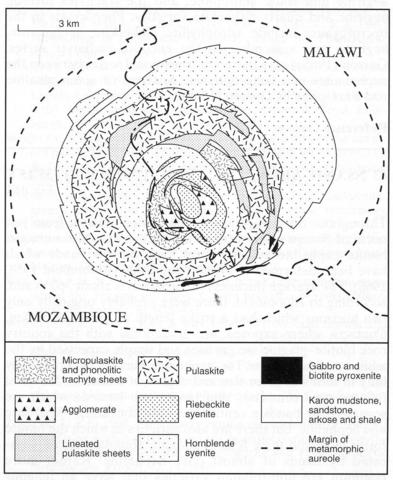stripes
The Salambidwe intrusion, the southern half of which lies in Mozambique, is a circular ring complex some nine kilometres in diameter forming a hill around which is a discontinuous ring of foothills built of Karoo sediments updomed and indurated by the intrusion. There is a dense dyke swarm which is essentially radial but the predominant solvsbergites extend to the northeast for over 100 km. The earliest intrusion was an oval plug of syenite of 8x7 km within the northwestern margin of which are abundant xenoliths and screens of syenitized and hornfelsed Karoo sediments. An intrusion of riebeckite syenite was then emplaced towards the centre of the syenite followed by a broad ring-dyke of pulaskite which lies wholly within the syenite. Garson (1965a) also distinguished sheets of lineated pulaskite up to 35 m thick that dip inwards at 5-65° and are apparently of ‘cone-sheet type’. Arcuate areas of agglomerate occur in several areas in the inner part of the complex and igneous activity concluded with intrusion of the radial dyke swarm and extensive faulting, which was also essentially radial. The early syenites are medium- to coarse-grained in the outer ring and fine- to medium-grained in the central area. They comprise perthite, a little oligoclase, hornblende and biotite; interstitial quartz may occur. In some varieties a pale green pyroxene rimmed by aegirine-augite is included in the hornblende which is in places replaced by fibrous riebeckite. The riebeckite syenite consists of perthite, a little albite or oligoclase, interstitial riebeckite and quartz, minor biotite and abundant zircon. The pulaskite of the ring-dyke is a leucocratic rock of perthite, minor interstitial albite or oligoclase, nepheline, sodalite or analcime, a brown amphibole with green rims, which encloses grains of augite, and late biotite that replaces amphibole and pyroxene. The pulaskite sheets are mineralogically similar but distinguished by the parallelism of the feldspar plates, amphibole and biotite. The agglomerates consist of rounded to subangular blocks up to 50 cm across of syenites, tuffisite, solvsbergite and trachyte in a comminuted matrix of similar material. The radial dykes include solvsbergite, trachyte, microsyenite, microfoyaite, nephelinite and lamprophyre. The solvsbergites are the most abundant and contain a little aegirine and sodic amphibole, and the trachytes include aegirine and quartz-riebeckite varieties. Phenocrysts in the microfoyaites include astrophyllite, riebeckite, aenigmatite, aegirine and a member of the eucolite-eudialyte series. Garson (1965a) says there is a transitional series between the nephelinites and lamprophyres. Analyses of seven alkaline rocks are given by Garson (1965a).
GARSON, M.S. 1965a. Carbonatites in southern Malawi. Bulletin, Geological Survey of Malawi. 15: 1-128.

